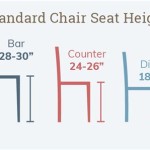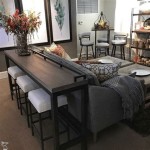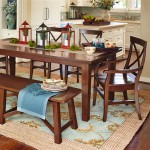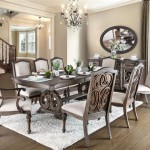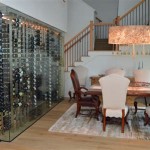Styles of Dining Room Tables: A Comprehensive Guide
The dining room table serves as a focal point for shared meals, conversations, and memories within a home. Selecting the appropriate dining room table necessitates careful consideration of various factors, including room size, existing décor, desired aesthetic, and intended usage. Understanding the diverse styles of dining room tables available provides a foundation for making an informed decision that aligns with individual needs and preferences.
Traditional Dining Room Tables
Traditional dining room tables embody classic design principles, often drawing inspiration from historical periods such as the Victorian, Georgian, and Queen Anne eras. These tables typically exhibit ornate detailing, rich wood finishes, and a sense of formality. Common characteristics include cabriole legs, intricate carvings, and substantial construction. Popular wood choices for traditional tables include mahogany, cherry, and walnut, known for their inherent beauty and ability to showcase intricate details.
The silhouette of a traditional dining room table often features rounded edges, adding a touch of softness to the overall design. Pedestal bases are frequently incorporated, lending an air of elegance and sophistication. The scale of traditional tables tends to be larger, designed to accommodate formal gatherings and multiple guests. Fabrics such as damask, velvet, or brocade are commonly used for accompanying chairs, further enhancing the sense of formality and opulence.
Traditional dining room tables are well-suited for homes characterized by a more formal architectural style or for individuals who prefer a timeless and elegant aesthetic. They require a larger dining room space to avoid appearing cramped or overwhelming the area. Proper maintenance is crucial for preserving the beauty and longevity of these tables, typically involving regular cleaning with appropriate wood care products and protection from excessive heat or moisture.
Modern Dining Room Tables
Modern dining room tables prioritize clean lines, minimalist designs, and a focus on functionality. This style emphasizes simplicity and avoids excessive ornamentation. Common materials used in modern dining tables include glass, metal, and lighter-toned woods such as maple and birch. Shapes are often geometric, featuring rectangular, square, or circular tops with streamlined legs or bases.
The emphasis on functionality is evident in the often-incorporation of features such as extendable leaves or drop-leaf designs, allowing the table to adapt to varying numbers of diners. Modern tables often feature sleek, minimalist legs made of metal or wood that may be straight or slightly tapered. The use of color is typically restrained, with neutral tones such as white, black, grey, and natural wood hues predominating. Accent colors may be introduced through accompanying chairs or table accessories.
Modern dining room tables are ideal for homes with a contemporary or minimalist aesthetic, as well as for individuals who value functionality and a streamlined design. They blend seamlessly into smaller spaces and provide a sense of openness. Maintenance usually involves wiping the table clean with a damp cloth and avoiding harsh chemicals that could damage the surface. The durability of modern tables varies depending on the materials used, but generally they are designed to withstand everyday use.
Rustic Dining Room Tables
Rustic dining room tables evoke a sense of warmth, informality, and connection to nature. These tables often incorporate reclaimed wood, distressed finishes, and natural materials such as stone or metal. The overall aesthetic is characterized by imperfections, textures, and a sense of handcrafted charm. Common wood choices include pine, oak, and reclaimed wood, often showcasing knots, grains, and variations in color.
The shapes of rustic tables can vary, ranging from rectangular to round to live-edge designs that preserve the natural contours of the wood. Legs may be simple and sturdy or feature more elaborate designs with metal accents or exposed joinery. The finish is typically matte or lightly oiled, allowing the natural beauty of the wood to shine through. Rustic tables often incorporate details such as visible wood grain, knots, and cracks, which contribute to their unique character. The use of natural textures such as linen or burlap for tablecloths and runners further enhances the rustic aesthetic.
Rustic dining room tables are well-suited for homes with a farmhouse, cottage, or eclectic décor style. They create a warm and inviting atmosphere, making them ideal for casual gatherings and family meals. Maintenance involves regular cleaning with a soft cloth and occasional oiling to preserve the wood's natural finish. The imperfections inherent in rustic tables contribute to their charm and character, so minor scratches or dents are often seen as adding to their appeal rather than detracting from their value.
Contemporary Dining Room Tables
Contemporary dining room tables represent the latest trends in design, often pushing boundaries and incorporating innovative materials and techniques. This style is characterized by its forward-thinking approach and its ability to adapt to evolving aesthetic preferences. Common materials used in contemporary tables include acrylic, glass, metal, and a wide range of engineered woods. Shapes can be unconventional, featuring asymmetrical designs, sculptural bases, and unexpected juxtapositions of materials.
The focus on innovation is evident in the incorporation of features such as built-in lighting, hidden storage compartments, or integrated technology. Contemporary tables often feature sleek, minimalist legs or bases that are made of metal, acrylic, or a combination of materials. The color palette can be bold and vibrant or more subdued, depending on the specific design. Contemporary tables often incorporate geometric patterns, abstract shapes, and unexpected textures.
Contemporary dining room tables are ideal for homes with a modern, cutting-edge décor style, as well as for individuals who appreciate innovation and a sense of individuality. They can serve as statement pieces, adding a touch of drama and sophistication to the dining room. Maintenance varies depending on the materials used, but generally involves regular cleaning with appropriate cleaning products and protection from scratches or dents. The durability of contemporary tables can vary depending on the materials used, but generally they are designed to withstand everyday use while making a bold stylistic statement.
Extendable Dining Room Tables
Extendable dining room tables offer a practical solution for accommodating varying numbers of guests, providing flexibility and adaptability to different dining needs. These tables feature a mechanism that allows them to be expanded or contracted, typically through the addition of leaves or drop-leaf designs. Extendable tables are available in a wide range of styles, from traditional to modern, allowing individuals to select a table that complements their existing décor while offering the added functionality of expandable seating.
Various mechanisms are used to extend dining room tables, including butterfly leaves, drop-in leaves, and self-storing leaves. Butterfly leaves are hinged extensions that fold out from beneath the table top, while drop-in leaves are separate pieces that are inserted into the center of the table. Self-storing leaves are stored within the table itself, making them easy to access and deploy when needed. The choice of mechanism depends on factors such as the size of the table, the desired level of convenience, and the overall aesthetic.
Extendable dining room tables are well-suited for homes that frequently host gatherings or for individuals who anticipate needing to accommodate varying numbers of diners. They provide a practical solution for maximizing space without sacrificing style or functionality. Maintenance involves regular cleaning with appropriate cleaning products and ensuring that the extension mechanism is properly lubricated to ensure smooth operation. The durability of extendable tables can vary depending on the materials used and the quality of the extension mechanism, so it is important to select a table that is built to withstand repeated use.
Round Dining Room Tables
Round dining room tables offer a unique aesthetic and functional advantages, promoting conversation and creating a sense of intimacy. The circular shape eliminates corners, allowing for equal seating and creating a more inclusive dining experience. Round tables are available in a wide range of styles, from traditional to modern, and can be made from various materials, including wood, glass, and metal. Their shape makes them particularly well-suited for smaller dining spaces, as they occupy less visual space and allow for easier movement around the table.
The absence of corners on a round table encourages eye contact and facilitates conversation, making it ideal for social gatherings and family meals. The symmetrical design of a round table creates a sense of balance and harmony, enhancing the overall aesthetic of the dining room. Round tables can be paired with a variety of chair styles, from traditional armchairs to modern minimalist chairs, allowing individuals to customize the look of their dining space. The size of the round table should be carefully considered to ensure that it is proportional to the size of the room and that it provides adequate seating for the intended number of diners.
Round dining room tables are well-suited for smaller dining spaces or for individuals who prioritize conversation and intimacy. They create a welcoming and inclusive atmosphere, making them ideal for social gatherings and family meals. Maintenance involves regular cleaning with appropriate cleaning products and protecting the table from scratches or dents. The durability of round tables can vary depending on the materials used, but generally they are designed to withstand everyday use.

The Complete Guide To Dining Tables Types And Styles Cabinfield Blog

A Quick Guide To Different Dining Room Table Styles

Guide To Tables

The Complete Guide To Dining Tables Types And Styles Cabinfield Blog

Different Dining Table Styles For Custom Design Keekea

How To Style A Dining Table

The Complete Guide To Dining Tables Types And Styles Cabinfield Blog

Choosing The Perfect Dining Table

A Guide To Antique Dining Tables Hemswell Centres

Common Dining Room Table Shapes Sizes And Base Types Furniture Showcase

